Related Research Articles

The Royal Regiment of Artillery, commonly referred to as the Royal Artillery (RA) and colloquially known as "The Gunners", is one of two regiments that make up the artillery arm of the British Army. The Royal Regiment of Artillery comprises thirteen Regular Army regiments, the King's Troop Royal Horse Artillery and five Army Reserve regiments.
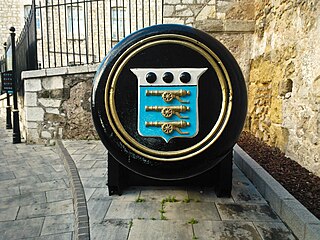
The Board of Ordnance was a British government body. Established in the Tudor period, it had its headquarters in the Tower of London. Its primary responsibilities were 'to act as custodian of the lands, depots and forts required for the defence of the realm and its overseas possessions, and as the supplier of munitions and equipment to both the Army and the Navy'. The Board also maintained and directed the Artillery and Engineer corps, which it founded in the 18th century. By the 19th century, the Board of Ordnance was second in size only to HM Treasury among government departments. The Board lasted until 1855, at which point it was disbanded.

During the American Civil War, the United States Army, the land force that fought to preserve the collective Union of the states, was often referred to as the Union Army, the Federal Army or the Northern Army. It proved essential to the restoration and preservation of the United States as a working, viable republic.
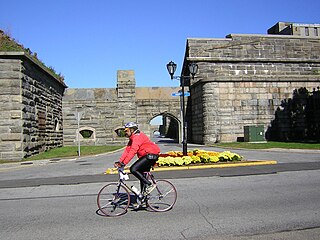
Fort Schuyler is a preserved 19th century fortification in the New York City borough of the Bronx. It houses a museum, the Stephen B. Luce Library, and the Marine Transportation Department and Administrative offices of the State University of New York Maritime College. It is considered one of the finest examples of early 19th century fortifications. The fort was named in honor of Major General Philip Schuyler of the Continental Army.
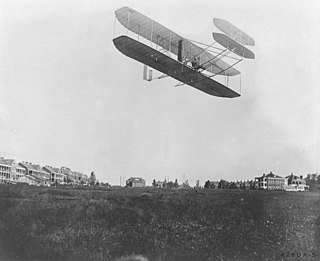
Fort Myer is the previous name used for a U.S. Army post next to Arlington National Cemetery in Arlington County, Virginia, and across the Potomac River from Washington, D.C. Founded during the American Civil War as Fort Cass and Fort Whipple, the post merged in 2005 with the neighboring Marine Corps installation, Henderson Hall, and is today named Joint Base Myer–Henderson Hall.

Fort Adams is a former United States Army post in Newport, Rhode Island that was established on July 4, 1799 as a First System coastal fortification, named for President John Adams who was in office at the time. Its first commander was Captain John Henry who was later instrumental in starting the War of 1812. The current Fort Adams was built 1824–57 under the Third System of coastal forts; it is part of Fort Adams State Park today.
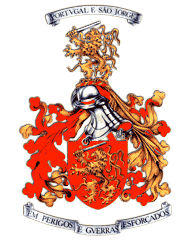
The Portuguese Army is the land component of the Armed Forces of Portugal and is also its largest branch. It is charged with the defence of Portugal, in co-operation with other branches of the Armed Forces. With its origins going back to the 12th century, it can be considered one of the oldest active armies in the world.
Master gunner is an appointment of the warrant officer rank in the British and United States armed forces.

Fort Washington, located near the community of Fort Washington, Maryland, was for many decades the only defensive fort protecting Washington, D.C. The original fort, overlooking the Potomac River, was completed in 1809, and was begun as Fort Warburton, but renamed in 1808. During the War of 1812, the fort was destroyed by its own garrison during a British advance.

The Royal Garrison Artillery (RGA) was formed in 1899 as a distinct arm of the British Army's Royal Regiment of Artillery serving alongside the other two arms of the Regiment, the Royal Field Artillery (RFA) and the Royal Horse Artillery (RHA). The RGA were the 'technical' branch of the Royal Artillery who were responsible for much of the professionalisation of technical gunnery that was to occur during the First World War. It was originally established to man the guns of the British Empire's forts and fortresses, including coastal artillery batteries, the heavy gun batteries attached to each infantry division and the guns of the siege artillery. The RGA was amalgamated with the RFA in 1924, from which time the only two arms within the Royal Regiment of Artillery have been the Royal Artillery and the Royal Horse Artillery.
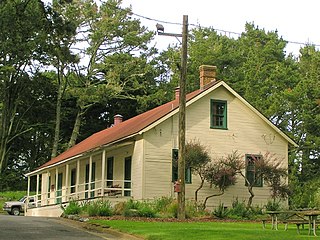
The Fort Miley Military Reservation, in San Francisco, California, sits on Point Lobos, one of the outer headlands on the southern side of the Golden Gate. Much of the site is part of the Golden Gate National Recreation Area, while the grounds and buildings that were converted into the San Francisco VA Medical Center are administered by the Veterans Health Administration of the US Department of Veterans Affairs.

Fort Michie was a United States Army coastal defense site on Great Gull Island, New York. Along with Fort H. G. Wright, Fort Terry, and Camp Hero, it defended the eastern entrance to Long Island Sound as part of the Harbor Defenses of Long Island Sound, thus defending Connecticut's ports and the north shore of Long Island.
Ordnance sergeant was an enlisted rank in the U.S. Army from 1832 to 1920. The Confederate States Army also had an ordnance sergeant position during its existence. Ordnance sergeants were part of the Army's Ordnance Department and were in charge of the ordnance stores at a particular fort or other Army post. Often they led caretaker detachments or were the sole caretakers of ungarrisoned fortifications and other facilities. In both armies the rank insignia consisted of three inverted chevrons with a 5-pointed star above it.

The Bermuda Garrison was the military establishment maintained on the British Overseas Territory and Imperial fortress of Bermuda by the regular British Army and its local militia and voluntary reserves from 1701 to 1957. The garrison evolved from an independent company, to a company of Royal Garrison Battalion during the American War of Independence, and a steadily growing and diversifying force of artillery and infantry with various supporting corps from the French Revolution onwards. During the American War of Independence, the garrison in Bermuda fell under the military Commander-in-Chief of America. Subsequently, it was part of the Nova Scotia Command until 1868, and was an independent Bermuda Command from then until its closure in 1957.
The 8th Coast Artillery Regiment was a Coast Artillery Corps regiment in the United States Army, which garrisoned the Harbor Defenses of Portland, Maine 1924–1944, and the Harbor Defenses of Portsmouth, New Hampshire 1924–1940.
The United States Army's enlisted rank insignia that was used during World War I differs from the current system. The color scheme used for the insignia's chevron was olive drab for field use uniforms or one of several colors depending on the corps on dress uniforms. The chevron system used by enlisted men during World War I came into being on July 17, 1902, and was changed to a different system in 1919. Specification 760, which was dated May 31, 1905, contained 45 different enlisted insignia that varied designs and titles by different corps of the Army. General Order Number 169, which was enacted on August 14, 1907, created an even larger variety of enlisted rank insignia. Pay grades similar to the current system were not yet in use by the U.S. Army, and instead, the pay system reflected the job assignment of the soldier rather than their rank. By the end of World War I, the system contained 128 different insignia designs.

The Bermuda Base Command was a command of the United States Army, established to defend the British Colony of Bermuda, located 640 miles off Cape Hatteras, North Carolina. It was created in April 1941 when United States Army troops were sent to the island.
The Harbor Defenses of Portsmouth was a United States Army Coast Artillery Corps harbor defense command. It coordinated the coast defenses of Portsmouth, New Hampshire and the nearby Portsmouth Naval Shipyard in Kittery, Maine from 1900 to 1950, both on the Piscataqua River, beginning with the Endicott program. These included both coast artillery forts and underwater minefields. The command originated circa 1900 as the Portsmouth Artillery District, was renamed Coast Defenses of Portsmouth in 1913, and again renamed Harbor Defenses of Portsmouth in 1925.

The Harbor Defenses of New Bedford was a United States Army Coast Artillery Corps harbor defense command. It coordinated the coast defenses of New Bedford, Massachusetts and the nearby Cape Cod Canal from 1900 to 1950, beginning with the Endicott program. These included a coast artillery fort and an underwater minefield. The command originated circa 1900 as the New Bedford Artillery District, was renamed Coast Defenses of New Bedford in 1913, and again renamed Harbor Defenses of New Bedford in 1925.
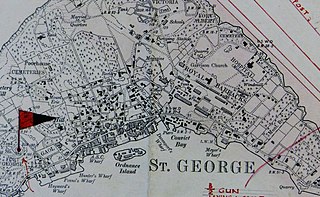
St. George's Garrison was the first permanent military camp of the Bermuda Garrison established in the British colony and Imperial fortress of Bermuda, with construction of Old Military Road and the original Royal Barracks commencing during the war between Britain and France that followed the French Revolution. It would remain in use until 1957, when it was transferred to the civil (colonial) government with most of the other Admiralty and War Office properties in Bermuda.
References
- ↑ Dean, C. G.T. (August 1944). "The Corps of Invalids". Royal United Services Institution. Journal. 89 (555): 282–287. doi:10.1080/03071844409434746. ISSN 0035-9289.
- ↑ Rostker, Bernard (2013). "The American System of Providing for the Wounded Evolves". Providing for the Casualties of War. RAND Corporation. pp. 63–64. ISBN 9780833078353. JSTOR 10.7249/j.ctt2tt90p.12.
- ↑ Invalid Corps, Historical Times Illustrated Encyclopedia of the Civil War
- ↑ Lande, R. Gregory. Invalid Corps, Military Medicine, Vol. 173, no. 6, 2008, pp. 525-528.
- ↑ United States War Department (December 30, 1913). "General Order No. 83". General Orders.
- ↑ United States House (1914). "Hearings Before the Committee on Military Affairs". Army Appropriation Bill, 1916. pp. 611–614. Major General Erasmus M. Weaver Jr., Chief of Coast Artillery, testifies to Congress on coast artillery matters including an explanation of caretakers in that service.